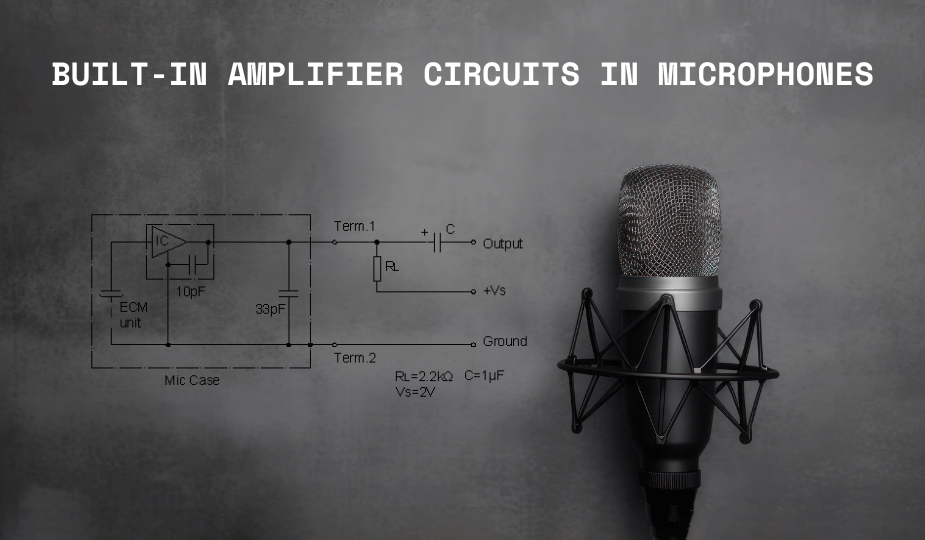
When designing microphones or selecting components for audio devices, the role of the built-in amplifier circuit cannot be overstated. Understanding the key parameters of these amplifier circuits is essential for achieving the best audio performance. In this guide, we will break down the critical parameters of amplifier circuits in microphones, such as gain, noise floor, THD (Total Harmonic Distortion), and input impedance, to help you make informed decisions about your microphone design.
1. Gain: Understanding the Amplification Power
Gain is one of the most critical parameters of a built-in amplifier circuit. It determines how much the microphone signal will be amplified. The higher the gain, the more powerful the signal.
Common gain values range from +20dB to +60dB, and selecting the right gain is essential for ensuring clear and audible sound. For example:
- Dynamic microphones typically require a gain of +25dB or more to amplify the signal sufficiently.
- Condenser microphones need less gain, typically in the range of +10dB to +30dB.
Tip: Too much gain can introduce noise. It’s important to balance the amplification to avoid distortion while ensuring adequate signal strength.
2. Noise Floor: Ensuring Clean Sound
Noise floor refers to the background noise level generated by the amplifier itself. A lower noise floor means cleaner, more professional sound quality.
Typical noise floor values range from -90dBu to -130dBu, with the lower values being better for high-quality recordings. For instance:
- A noise floor of -100dBu or lower is ideal for professional recording environments where minimal background noise is essential.
- A noise floor of -90dBu is acceptable for entry-level microphones in quiet environments.
Warning: Some cheaper amplifiers may advertise high gain but suffer from high noise, leading to unwanted hiss and hum in recordings.
3. THD: The Impact on Audio Quality
THD (Total Harmonic Distortion) measures how much the original sound signal is altered by the amplifier. A lower THD means the signal is preserved more accurately.
Common THD values range from 0.001% (high-end quality) to around 0.1% (entry-level). Here’s how to choose based on your needs:
- For recording applications requiring high fidelity, such as voice recording or podcasts, a THD of <0.01% is recommended for a clean, natural sound.
- For music production, some may prefer a slightly higher THD (around 0.1%) to add warmth or character to the sound.
Tip: While lower THD is generally better, some distortion may be desirable for specific applications like music or creative sound design.
4. Input Impedance: Matching with Microphones
Input impedance refers to the compatibility between the amplifier and the microphone element. The right impedance ensures optimal signal transfer and prevents signal loss.
Common input impedance values for amplifiers are:
- 1kΩ to 3kΩ for dynamic microphones
- 150Ω to 300Ω for condenser microphones
Tip: For dynamic microphones, ensure the amplifier has an impedance of at least 1kΩ to avoid dull or muffled sound. For ribbon microphones, a higher impedance is required, typically over 2kΩ for accurate frequency response.
How to Choose the Right Built-in Amplifier Circuit for Your Microphone
When selecting an amplifier circuit for your microphone, consider the following:
- For professional-grade recording, prioritize a low noise floor and an appropriate gain level for your microphone type.
- For specific applications like music production, you may opt for a slightly higher THD to add character to the sound.
- Ensure the input impedance matches your microphone’s requirements to avoid signal degradation.
Ready to Optimize Your Microphone Design?
Understanding the key parameters of built-in amplifier circuits is the first step in creating high-performance microphones. Whether you’re designing a microphone for professional audio applications or a specific project, the right amplifier circuit can make all the difference.
If you’re looking to improve your microphone’s performance or need assistance in selecting the right amplifier components, contact us today. Our team of experts is here to help you find the perfect solution for your microphone design needs.


